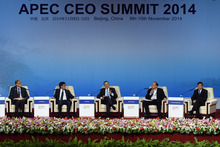Nov 11, 2014
NZ well placed to ensure quality

A comprehensive free trade area of the Asia-Pacific has long been an ambition of Apec, as befits the name of the 21-strong group of nations. But the diversity of the countries within the Asia-Pacific Economic Co-operation bloc has meant it has stayed on the backburner. Until now, that is. At China’s behest, a meeting of Apec trade ministers in Beijing has agreed to a “strategic study” on a vast Free Trade Area of the Asia-Pacific. With negotiations for the Trans-Pacific Partnership making limited progress, that represents welcome news for this country.
The proposed Asia-Pacific pact is not about to overtake the TPP in importance. A large number of issues, not least between the United States and Japan, mean it will be no less difficult to negotiate. As much was underlined by the 2025 target date floated at the trade ministers’ conference. There is a sense also that China may have grasped the concept as much for geo-political as economic reasons. It needs to confirm its growing influence in the Pacific Rim by taking something from the Beijing conference, not have it dominated by behind-the-scenes talk on the US-backed TPP, from which it is excluded.
This has prompted strong advocacy of the Asia-Pacific free trade area by the Chinese media. They have pushed for it to be accelerated as a solution to the present “spaghetti bowl” of competing free trade proposals. That represents a slight on the TPP, whose 12 prospective members also belong to Apec. The Americans, however, are insistent that any Asia-Pacific talks will not impede progress on the TPP. The trade ministers’ joint statement said, therefore, any Asia-Pacific pact would build on “ongoing regional undertakings” – a reference to the TPP and other regional trade agreements.
New Zealand is in a fortunate position. The benefits of its free trade agreement with Beijing mean that it does not, of course, want the TPP to be used to isolate and antagonise China. It could well push the proposition that a gold-standard TPP agreement, if concluded, could in time be expanded to include the Chinese. The prospects of such an agreement have been heightened by the success of the Republicans in claiming control of Congress in America’s mid-term elections. As much as President Barack Obama has committed himself to the TPP, the Democrats are the more protectionist-minded of the two parties.
But if the TPP negotiations founder, the China-backed Asia-Pacific proposal will take on a new significance. At a time when World Trade Organisation negotiations are paralysed, it is also of benefit that this country is a member of the Regional Comprehensive Economic Partnership. That involves the 10 members of Asean and their six free trade partners, including China, India and Japan but not the US. Negotiations began last year and are scheduled to conclude by the end of 2015. But the insertion of a flexibility clause suggests this may not, initially at least, be a high-standard pact. It may include a two-stage process, one for ambitious free trade proponents, such as New Zealand, and another speed for countries such as Japan.
The development of the trade and economic framework of the Asia-Pacific region is clearly gathering pace. New Zealand and Australia, which will soon enter its own long-delayed free trade pact with Beijing, have a significant role to play in this. Their good relations with China and the US make them well placed to guard against strategic tensions warping free trade negotiations. In a region that boasts almost half the world’s trade, they are relatively small voices. But they should be trying to use these to make a telling impact.
